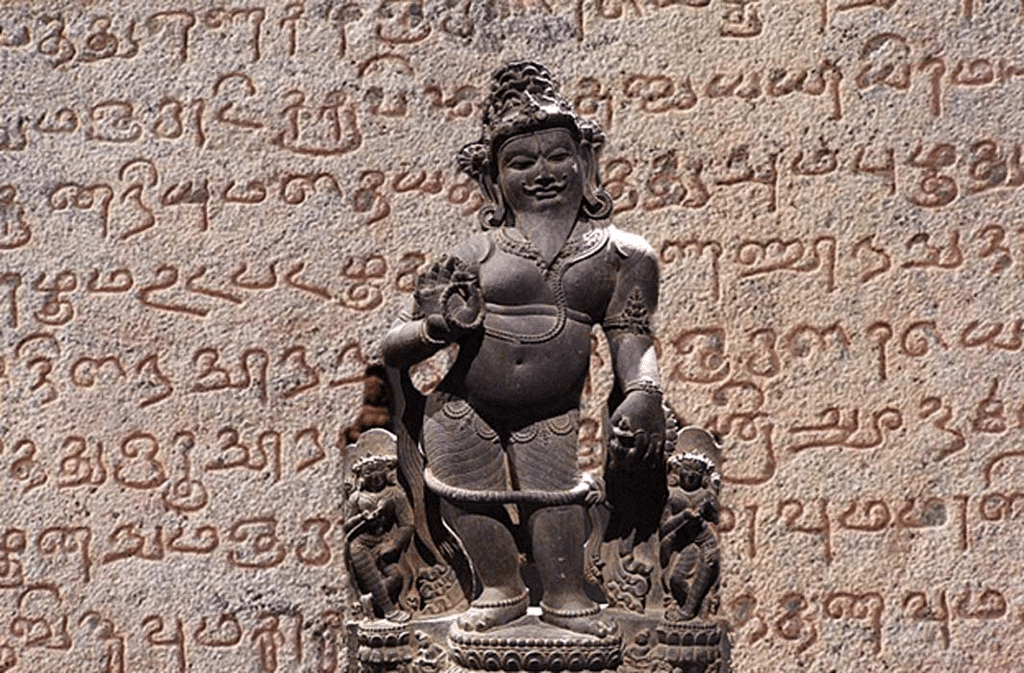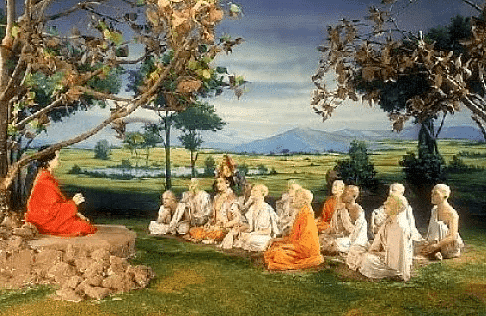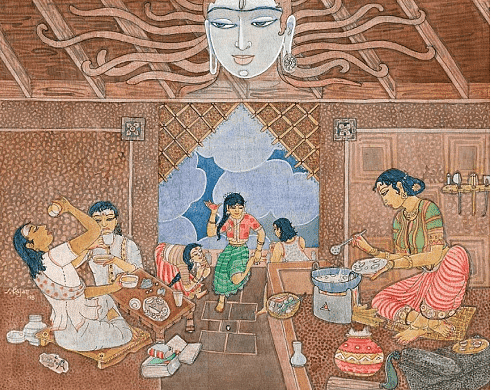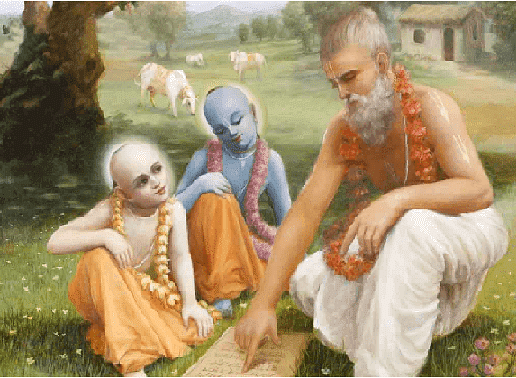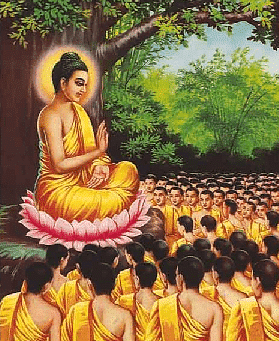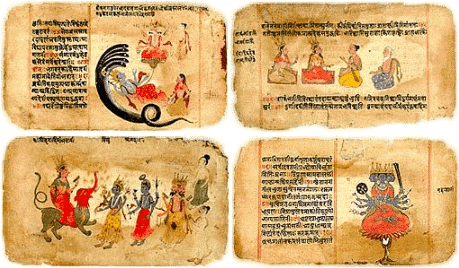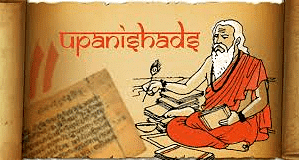The Sangam Age
- From available evidence it can be said that there is a body of literature in Tamil which has had unbroken development over twenty centuries.
- The earliest known phase of this literature is usually designated the Sangam literature for the reason that the anthologies of odes, lyrics and idylls which form bulk of that literature, were composed at a time when the Pandyan kings of Madurai maintained in their court a body of eminent poets who in a sort of unofficial way functioned as a board of literary censors.
- Later poets and scholars like saint Navukharasar and the commentator on the Iraiyanar Ahapporul used the expression sangam to denote this association of scholars.
 Sangam Period
Sangam Period - Though it is difficult to accept all the interesting but obviously legendary details about this Sangam given by later writer as authentic history, yet it would equally difficult to reject the fact of the existence of an institution like the Sangam.
- The preface to the Tolkappiyam speaks of the practice of learned treatise being critically examined by court poets.
- A good part of the literature that was produced during the Sangam period has perished.
- Legendary and traditional accounts mention the loss of many texts on the occasion of ‘deluge’ which compelled the Pandyan kings to shift their capital first from Ten-Madurai to Kapatapuram and then from there to Madurai.
- The currently extend body of sangam literature is but a fraction of vast literature.
Extent
- The Pandya country occupied the extreme south and included the modern districts of Madurai, Ramnad and Tirunelveli. Its capital was Madurai (earlier Ten-Madurai and then Kapatapuram served as their capitals). Korkai was its main seaport. Saliyur was another seaport.
- The Chola country comprised the lower Kaveri Valley. It roughly corresponded to modern Tanjore and Tiruchirapalli districts; its inland capital was Uraiyur later Puhar.
- The Chera or Kerala kingdom was the western coastal strip above the northern limit of the Pandyan kingdom. Tondi and Muziris were the best known port. Vanji or Karur was its capital.
Political History
- The three major kingdoms Cheras, Cholas and Pandyas ruled over Tamiliham. (The extreme south of India from the Tirupati hill to Cape Comorin (Kanya Kumari) bounded by the sea on the east and west, was known as Tamiliham.
- The second Rock Edict of Ashoka mentions the names of the Cholas, Pandyas, Satiyaputra and Keralaputra. These countries lay outside the empire of Ashoka.
- The Chera kingdom was the oldest of the three.
- The king was the very centre and embodiment of administration.
- The most common form of government in the Sangam age was hereditary monarchy.
- The king was called Ko, Mannam, Vendan, Korravan, etc.
- The king’s power was restricted by five councils. These five consisted of:
1. Amaichchar (ministers)
2. Purohitar (priests)
3. Senapatiyar (army chiefs)
4. Dutar (ambassadors)
5. Orrar (spies).
- The ministers advised the kings on matters on which they were consulted.
- The village was the smallest unit of administration. The small village assembly met there to transact local business.
- The entire kingdom was called Mandalam.
- Below the Mandalam a major division was Nadu.
- The Ur was a town which was sometimes described as a big village (Perur), a small village (Sirur) or an old village (Mudur).
- Pattinam was the name for a coastal town and Puhar was the harbour area.
- Salai was the trunk road and Teru the street in a town.
- Uraiyar was the Chola inland capital; Korkai was the Pandyan coastal capital and Madurai was the Pandyan inland capital. Musiri was the Chera port.
The Cheras
- Udiyanjeral was the first important Chera king. The title vanavaramban and perunjoran udiyan are applied to him by the poet Mudinagarayar in Puram.
Know the Important Facts
- The extreme south of India from the Tirupati hill (Vengadam) to Cape Camorin (Kanya Kumari), bounded by the sea on the east and west, was known as Tamilagan or Tamilham.
- The second and thirteenth Rock Edicts of Ashoka mention the southern kingdoms and Sri Lanka.
- The list in the second Edict, which comprises by name the Cholas, Pandyas, Satiyaputra and Keralaputra, besides Tambraparni.
- Tamil is the oldest among the spoken literary languages of South India.
- Virtually no Roman coins of the third century have been found in India.
- The first and second centuries A.D. formed the period when Roman trade with India was brisk.
- Muziri and Tondi on the west coast of South India, Korkai and Kaveripattinam on the east were among the chief ports of the Tamil land.
- There is a reference in Silappadikaram to king Gajabahu I of Sri Lanka being present on the occasion of the installation of a temple to Kannagi, by the Chera king Senguttuvan.
- Gajabahu I of Sri Lanka is known to have ruled in the second half of the second century A.D., and so Senguttuvan is assigned to that century.
- Senguttuvan, also known as the Red Chera was the son of Nedenjeral. He was the greatest of the Cheras and built a temple to Kannaji, the heroine of Silappadikaram.
- Senguthuvan was the contemporary of the poet Pannar.
- According to Silappadikaram Senguthuvan was the founder of the Pattini cult related to the worship of the goddess of chastity.
- The cheras were known by many equivalent titles Vannar, Villavar, Khudavar, Kuttuvar, Malaiyar and Poraiyar etc.
The Cholas
- Karikala was the greatest king of the Cholas. He was a contemporary of the Chera King Perunjeral Adan. He founded the new capital at Puhar.
- According to tradition recorded in Manimekalai, a good part of the port town of Puhar was engulfed by the sea during the reign of Chola King Killivalavan.
- The Cholas were known as Sennis, Sembiyas, Valavan and Killi.
The Pandyas
- Sangam literature refers primarily to Pandyan kingdom but also contains informations about Cholas and Cheras.
- Pandyas were the first south Indian kindgom to be mentioned by Megasthenes and it was the first literary evidence of south Indian kingdoms.
- Nedunjeliyan was the most important king of the Pandyas mentioned in Silappadikaram.
- The earliest known Pandyan ruler was Palyagasalai Mudukudumi.
- According to Silappadikaram, Nedunjelliyan, in a fit of passion, ordered, without judicial enquiry, the execution of Kovalan, the hero of Silappakigaram. Kovalan was accused of theft but later Kovalan’s wife Kannagi proved her husband’s innocence. The king was struck with remorse and died of shock on the throne.
- The Pandyas were known as Manivar, Kavuriyar, Panchavar, Seliyar, Marar, Valudi and Tennar etc.
